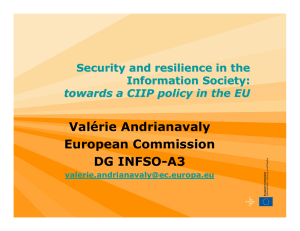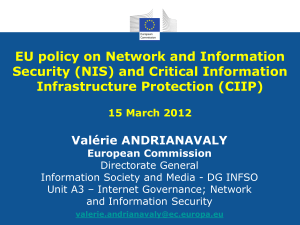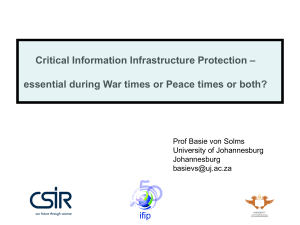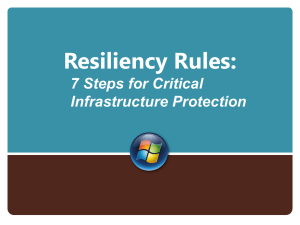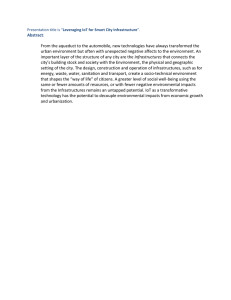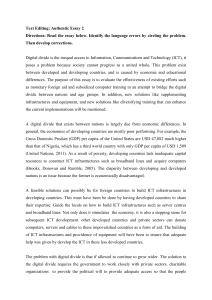Andrea Servida Deputy Head of Unit European Commission DG INFSO-A3
advertisement
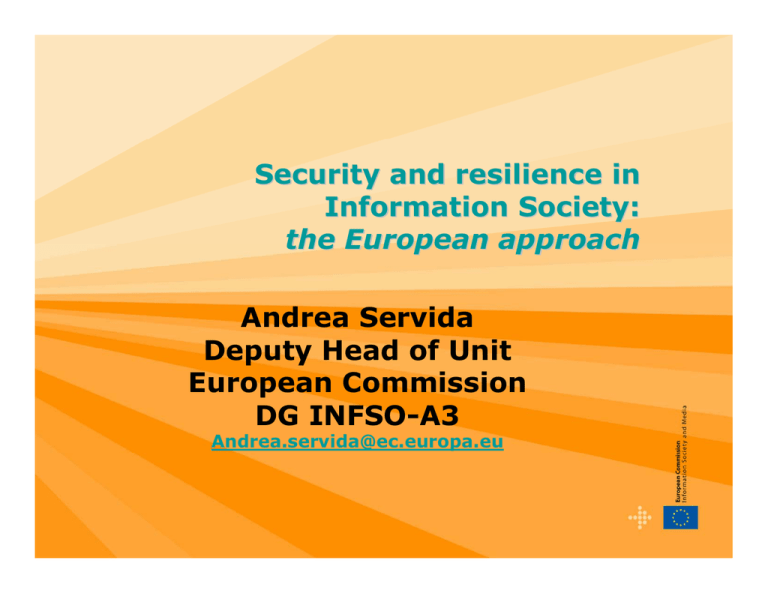
Security and resilience in Information Society: the European approach Andrea Servida Deputy Head of Unit European Commission DG INFSO-A3 Andrea.servida@ec.europa.eu What’s ahead: mobile ubiquitous environments Broaden communication parties, networking, and business opportunities Ubiquitous World Mobile World (Real World) B3G Radio Access Networks with low performance devices (e.g. RF tags and sensors) B3G Mobile Network Networks with high performance devices (e.g. home appliances) Mobile NW Ubiquitous Local NW Mobile Edge Mobile-Ubiquitous NW The key objectives of the strategy … to revitalise the EC strategy set out in 2001 – By reviewing the NIS situation and challenges posed by convergence of technologies, media and markets – By building better coordination between the various EC policy initiatives (e.g. spam, 2006 Review, CIIP, cyber crime, RFID, etc) – By mobilising all stakeholders to strengthen the cooperation in the EU … to adapt the EU approach to future challenges – By strengthening the role of ENISA – By emphasising the value and benefits of measuring and learning – By launching few actions to stimulate the exchange of good policy practice across the EU NIS in the Information Society TECHNICAL dimension SOCIAL dimension TRUSTWORTHY, SECURE & RELIABLE ICT ECONOMIC dimension LEGAL dimension Depending on ICT Today Today issues issues Pervasiveness, Pervasiveness,interdependencies interdependencies and andintrusiveness intrusiveness Influencing Influencingfactors factors ¾¾ incompatibility incompatibilitybetween betweentechnology technology and human systems and human systems ¾¾ technology-push technology-pushwith withno nothinking thinking ininterms termsof ofsocietal societalimpact impact(DRM, (DRM, TC, TC,biometrics, biometrics,IPv6, IPv6,etc.) etc.) ¾¾ emergence emergenceof ofnew newsocial socialand and governance governancemodels models ¾¾ little littleunderstanding understandingof ofhuman humanfactor factor ¾¾ excessive excessivetechnical technicalcontrol controlmay mayput put at atrisk risk“rights” “rights”(DRM, (DRM,biometrics, biometrics, TC, TC,etc.) etc.) ¾¾ there thereare areno nosafeguards safeguardsfor forusers users ¾¾ no noattention attentionto toeconomic economicand and societal costs of faulty software societal costs of faulty software Future Future objective objective Develop Developaa“respectful”, “respectful”,productive, productive, innovative innovativeand andsecure secureIS IS How Howto togo goabout aboutitit ¾¾ develop developaanew newethics ethicsof ofdigital digital behaviour behaviourand andcommercial commercialconduct conduct ¾¾ enforce enforceeverywhere everywherethe theprinciple principleof of user’s user’schoice choice ¾¾ promote promotethe therespect respectof ofthe thepersonal personal sphere spherealso alsoby byensuring ensuringresiliency resiliencyand and accountability accountabilityof ofsystems systems ¾¾ investigate investigateinterdependencies interdependencies between betweentechnology technology &&societal societal systems systems ¾¾ develop developaavision visionon onhow howto todepend depend on ontechnology technology(including (includinginternational international governance) governance)ininsocietal societalsystems systems ¾¾ education educationand andawareness awareness The key principles … … to improve and develop a culture of NIS • Technical – Promote diversity, usability openness and interoperability as integral components of security • Economic – Present NIS as a virtue and an opportunity • Social – Individual users need to understand that their home systems are critical for the overall security chain • Legal – Privacy and security are a prerequisite for guaranteeing fundamental rights on-line The challenges for stakeholders … … to take responsibility for their respective roles • Public Administrations – to address the security of their own networks and serve as an example of best practice for other players • Private sector enterprises – to address NIS as an asset and an element of competitive advantage an not as a “negative” cost • Individual users – to understand that their home systems are critical for the overall “security chain” Towards a secure Information Society DIALOGUE PARTNERSHIP structured and multi-stakeholder greater awareness & better understanding of the challenges Open & inclusive multi-stakeholder debate EMPOWERMENT commitment to responsibilities of all actors involved Dialogue • “Benchmarking” national NIS-related policies – Comparing to learn and to transfer best practices to improve awareness among SMEs & individual users to – public administrations shall act as ‘intelligent’ users and serve as an example for best practice drivers (-> eID) Structured multi-stakeholder dialogue – where to strike the balance between security and the protection of fundamental rights (-> PET, TC) – develop a sector-specific policy for the ICT sector to enhance the security and the resilience of information and communication networks (-> CIIP) Business Summit & User Seminar – stimulate industry commitment to adopt effective approaches to implement a culture of security in industry – raise security awareness and strengthen the trust of endusers Partnership • Improve knowledge of the problem – ENISA is asked to develop a trusted partnership with Member States and stakeholders to create a data collection framework to collect EU-wide data on security incidents and consumer confidence • Understand the ICT security sector and market in the EU – fostering a strategic relationship between governments, businesses and research community to deliver data on trends in ICT security • Support response capability – ENISA is asked to examine the feasibility of a European information sharing and alert system (including a multi-lingual security portal) Empowerment: invite Member States – Proactively participate in the proposed benchmarking exercise of national NIS policies; – Promote, in close cooperation with ENISA, awareness campaigns on the virtues, benefits and rewards of adopting effective security technologies, practices and behaviour; – Leverage the roll-out of e-government services to communicate and promote good security practices that could then be extended to other sectors; – Stimulate the development of network and information security programmes as part of higher education curricula. Empowerment: invite private sector • • • • • • Develop an appropriate definition of responsibilities for software producers and Internet service providers in relation to the provision of adequate and auditable levels of security. Here, support for standardised processes that would meet commonly agreed security standards and best practice rules is needed. Promote diversity, openness, interoperability, usability and competition as key drivers for security as well as stimulate the deployment of security-enhancing products, processes and services to prevent and fight ID theft and other privacy-intrusive attacks. Disseminate good security practices for network operators, service providers and SMEs as baseline levels for security and business continuity. Promote training programmes in the business sector, in particular for SMEs, to provide employees with the knowledge and skills necessary to effectively implement security practices. Work towards affordable security certification schemes for products, processes and services that will address EU-specific needs (in particular with respect to privacy). Involve the insurance sector in developing appropriate risk management tools and methods to tackle ICT-related risks and foster a culture of risk management in organisations and business (in particular in SMEs). The multi-stakeholder Dialogue on CIIP Plans on CIIP • • • • • • • In June 2004, the European Council asked for an overall strategy to protect critical infrastructures On 17 November 2005, the Commission adopted a Green Paper on the policy options for a European Programme on Critical Infrastructure Protection (COM(2005)576) Contributions were received from 22 Member States and over 100 private companies and industry associations Contributions confirm the need for action at the European level to enhance the protection and resilience of critical infrastructures Because of their horizontal nature with inter-linkages into many other critical infrastructures, the protection of communication and information infrastructure is a priority We are planning a Europe-wide dialogue on CIIP with public and private stakeholders in the fall A major policy initiative on CIIP will be launched in 2008 Challenges of the CIIP dialogue • Organisational: to build trusted relationships and motivate the stakeholders (in particular the private sector) • Policy orientations: to achieve a better understanding and clarity on the guiding policy principles • Issues: National vs. European Infrastructures; long-term Internet stability & resilience; preventive, detection/early warning & responsive measures; recovery and continuity strategies; sharing knowledge and good practices; cross-sectors proactive information assurance methods; risk management culture and tools; inter-dependencies, in particular across heterogeneous infrastructures; etc. CIIP - Preparatory study in 2006 “Availability and Robustness of Electronic Communications Infrastructures” – Aimed at identifying the threats and vulnerabilities in next generation 3G mobile and Internet core networks – developed 10 recommendations to MS, EU institutions and private sector to avoid or reduce their potential impact on the European Critical Infrastructure; – Ended February 2007 - the contractor is Alcatel–Lucent; – validation Workshop held in January 2007 – Comments invited until mid May 2007 – Final report available http://ec.europa.eu/information_society/newsroom/cf/itemdeta il.cfm?item_id=3334 CIIP – Initial discussions “Informal meeting of National experts on CIIP – Brussels, 19 January 2007” – Aimed informally discuss the outcomes AlcatelLucent study as well as exchange views on the CIIP component of EPCIP; – The Focus was on • the needs, challenges and opportunities for an EU dialogue on CIIP; • How a EU dialogue could add value to the National initiatives; • Who should be part of such a dialogue; • How to engage the public and the private sector; • What are the main issues to address CIIP – Initial discussions (2) “Joint Member States and private sector meeting – Brussels, 18 June 2007” – To debate the policy options for the EU; – Exchange views on how resilience and robustness are approached and tackled in the EU; – Focus on identifying: • • • • The The The The policy options for an EU dialogue on CIIP; roadmap for an EU initiative; role of stakeholders; mechanisms for an EU multi-stakeholder dialogue CIIP - Preparatory study in 2007 “Study on critical dependencies of energy, finance and transport infrastructures on ICT infrastructures” – Examine what are the critical ICT based dependencies in the sectors under consideration; – Identify and assess existing (cross-sector) early warning systems and protection strategies; – Identify existing (cross-sector) best practices where available to counter or mitigate cyber vulnerabilities and threats. Call for tender 165210 - 2007/S 135/2007 deadline for submission 5 October 2007 CIIP - Preparatory study in 2008 • We are planning activity to: – Identify the rationale and propose the criteria for the identification of European Critical Information Infrastructures; – Improve the emergency preparedness in the field of fixed and mobile telecommunication and Internet; – Proof of concept for a European Information Sharing and Alert System; – Identify the rationale and propose the criteria for the identification of European Critical Information Infrastructures in the sub-sector instrumentation automation and control systems; –… Web Sites A Strategy for a secure Information Society – “Dialogue, Partnership and empowerment” COM(2006) 251 http://ec.europa.eu/governance/impact/docs/ia_2006/com_2006_0251_en.pdf Commission Staff Working Document – Impact Assessment SEC(2006) 656 http://ec.europa.eu/governance/impact/docs/ia_2006/sec_2006_0656_en.pdf Background information (including the COM in all languages) http://europa.eu.int/information_society/newsroom/cf/itemlongdetail.cfm?item_id=2766 http://eur-lex.europa.eu/LexUriServ/LexUriServ.do?uri=CELEX:52006DC0251:EN:NOT
